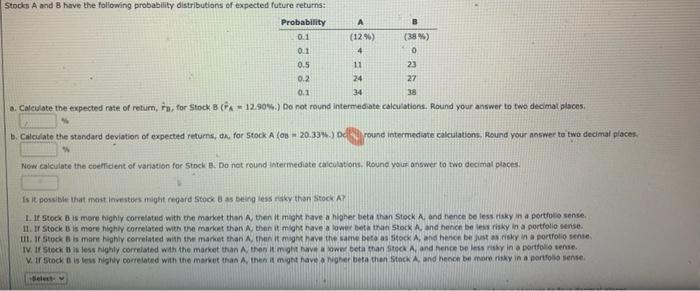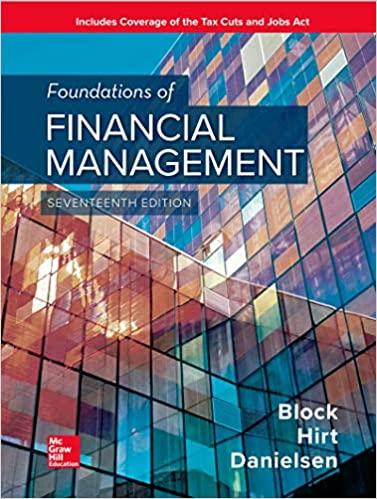
Stocks A and B have the following probability distributions of expected future returns: Probability 0.1 0.1 0.5 11 23 0.2 24 27 0.1 34 38 a. Calculate the expected rate of return, F, for Stock B (FA 12.90%.) Do not round intermediate calculations. Round your answer to two decimal places. % b. Calculate the standard deviation of expected returns, da, for Stock A (os 20.33%.) Do round intermediate calculations, Round your answer to two decimal places. % Now calculate the coefficient of variation for Stock B. Do not round intermediate calculations. Round your answer to two decimal places. Is it possible that most investors might regard Stock 8 as being less risky than Stock A 1. If Stock B is more highly correlated with the market than A, then it might have a higher beta than Stock A, and hence be less risky in a portfolio sense. 11. If Stock B is more highly correlated with the market than A, then it might have a lower beta than Stock and hence be less risky in a portfolio sense. beta as Stock A, and hence be just as risky in a portfolio sense. III. If Stock B is more highly correlated with the market than A, then it might have t IV. If Stock B is less highly correlated with the market than A, then it might have lower beta than Stock A, and hence be less risky in a portfolio sense. V. If Stock B is less highly correlated with the market than A, then it might have a higher beta than Stock A, and hence be more risky in a portfolio sense. -Select- A (12%) 4 B (38%) 0 c. Assume the risk-free rate is 2.5%, What are the Sharpe ratios for Stocks A and B? Do not round intermediate calculations. Round your answers to four decimal places. Stock A: Stock B: Are these calculations consistent with the information obtained from the coefficient of variation calculations in Part b? I. In a stand-alone risk sense A is less risky than B. If Stock B is less highly correlated with the market than A, then it might have a higher beta than Stock A, and hence be more risky in a portfolio sense. 11. In a stand-alone risk sense A is more risky than B. If Stock B is less highly correlated with the market than A, then it might have a lower beta than Stock A, and hence be less risky in a portfolio sense. III. In a stand-alone risk sense A is more risky than 8. If Stock 8 is less highly correlated with the market than A, then it might have a higher beta than Stock A, and hence be more risky in a portfolio sense. IV. In a stand-alone risk sense A is less risky than B. If Stock B is more highly correlated with the market than A, then it might have the same beta as Stock A, and hence be just as risky in a portfolio senise. V. In a stand-alone risk sense A is less risky than B. If Stock 8 is less highly correlated with the market than A, then it might have a lower beta thain Stock A, and hence be less risky in a portfolio sense. Select








